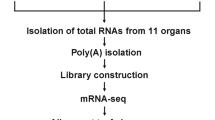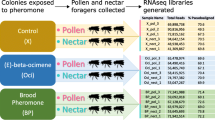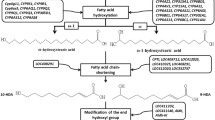Abstract
Honey bee is a social insect. Its colony is mainly coordinated by the chemical signals such as pheromones produced by queen or brood. Correspondingly, the worker bee developed numerous complicated olfactory sensilla in antennae for detection of these colony chemical signals and nectar/pollen signals in foraging. With the normal development of new emerged workers, young adults (nurse bee) worked in colony at the first 2–3 weeks and then followed by the foraging activity outside of the hive, which give rise to great change of the surrounding chemical signals. However, the olfactory adaption mechanism of worker bee in these processes of behavioral development is still unclear. In this study, we conducted a comprehensive and quantitative analysis of gene expression in Apis mellifera antenna of newly emerged workers, nurses and foragers using transcriptome analysis. Meanwhile, we constructed experimental colonies to collect age-matched samples, which were used to determine whether task is the principal determinant of differential expression. RNA sequencing and quantitative real-time polymerase chain reaction revealed that 6 and 14 genes were closely associated with nurse and forager behaviors, respectively. Furthermore, a broad dynamic range of chemosensory gene families and candidate odorant degrading enzymes were analyzed at different behavior statuses. We firstly reported genes associated with nursing/foraging behavior from antennae and the variations of expression of genes belonging to various olfactory gene families at different development stages. These results not only could contribute to elucidating the relationship between olfactory and behavior-related changes, but also provide a new perspective into the molecular mechanism underlying honey bee division of labor.




Similar content being viewed by others
References
Ament SA, Corona M, Pollock HS, Robinson GE (2008) Insulin signaling is involved in the regulation of worker division of labor in honey bee colonies. Proc Natl Acad Sci USA 105:4226–4231
Anders S, Huber W (2010) Differential expression analysis for sequence count data. Genome Biol 11:1–13
Benjamini Y, Hochberg Y (1995) Controlling the false discovery rate: a practical and powerful approach to multiple testing. J R Stat Soc B 57:289–300
Braks MAH, Meijerink J, Takken W (2001) The response of the malaria mosquito, Anopheles gambiae, to two components of human sweat, ammonia and L-lactic acid, in an olfactometer. Physiol Entomol 26:142–148
Briand L, Swasdipan N, Nespoulous C, Bézirard V, Blon F, Huet J, Ebert P, Penollet J (2002) Characterization of a chemosensory protein (ASP3c) from honeybee (Apis mellifera L.) as a brood pheromone carrier. Eur J Biochem 269:4586–4596
Brockmann A, Dietz D, Spaethe J, Tautz J (2006) Beyond 9-ODA: sex pheromone communication in the European honey bee Apis mellifera L. J Chem Ecol 32:657–667
Chertemps T, Younus F, Steiner C, Durand N, Coppin CW, Pandey G, Oakeshott JG, Maïbèche M (2015) An antennal carboxylesterase from Drosophila melanogaster, esterase 6, is a candidate odorant-degrading enzyme toward food odorants. Front Physiol 6:315
Conte YL, Arnold G, Trouiller J, Masson C, Chappe B (1990) Identification of a brood pheromone in honeybees. Naturwissenschaften 77:334–336
Dani FR, Iovinella I, Felicioli A, Niccolini A, Calvello MA, Carucci MG, Qiao H, Pieraccini G, Turillazzi S, Moneti G (2010) Mapping the expression of soluble olfactory proteins in the honeybee. J Proteome Res 9:1822–1833
Dissous C (2015) Venus kinase receptors at the crossroads of insulin signaling: their role in reproduction for helminths and insects. Front Endocrinol 6:118
Esslen J (1976) Zahl und verteilung antennaler sensillen bei der honigbiene (Apis mellifera L.). Zoomorphology 83:227–251
Fang Y, Song F, Zhang L, Aleku DW, Han B, Feng M, Li J (2012) Differential antennal proteome comparison of adult honeybee drone, worker and queen (Apis mellifera L.). J Proteom 75:756–773
Feng M, Song F, Aleku DW, Han B, Fang Y, Li J (2011) Antennal proteome comparison of sexually mature drone and forager honeybees. J Proteome Res 10:3246–3260
Forêt S, Maleszka R (2006) Function and evolution of a gene family encoding odorant binding-like proteins in a social insect, the honey bee (Apis mellifera). Genome res 16:1404–1413
Forêt S, Wanner KW, Maleszka R (2007) Chemosensory proteins in the honey bee: Insights from the annotated genome, comparative analyses and expressional profiling. Insect Biochem Mol Biol 37:19–28
Galizia CG, Szyszka P (2008) Olfactory coding in the insect brain: molecular receptive ranges, spatial and temporal coding. Entomol Exp Appl 128:81–92
Gary NE (1962) Chemical mating attractants in the queen honey bee. Science 136:773–774
Geier M, Bosch OJ, Boeckh J (1999) Ammonia as an attractive component of host odour for the yellow fever mosquito, Aedes aegypti. Chem Senses 24:647–653
He XJ, Zhang XC, Jiang WJ, Barron AB, Zhang JH, Zeng ZJ (2016) Starving honey bee (Apis mellifera) larvae signal pheromonally to worker bees. Sci Rep 6:22359
Hojo MK, Ishii K, Sakura M, Yamaguchi K, Shigenobu S, Ozaki M (2015) Antennal RNA-sequencing analysis reveals evolutionary aspects of chemosensory proteins in the carpenter ant, Camponotus japonicus. Sci Rep 5:13541
Huang ZY, Robinson GE, Tobe SS, Yagi KJ, Strambi C, Strambi A, Stay B (1991) Hormonal regulation of behavioural development in the honey bee is based on changes in the rate of juvenile hormone biosynthesis. J Insect Physiol 37:733–741
Ishida Y, Leal WS (2005) Rapid inactivation of a moth pheromone. Proc Natl Acad Sci USA 102:14075–14079
Ishida Y, Leal WS (2008) Chiral discrimination of the Japanese beetle sex pheromone and a behavioral antagonist by a pheromone-degrading enzyme. Proc Natl Acad Sci USA 105:9076–9080
Jin X, Brandazza A, Navarrini A, Ban L, Zhang S, Steinbrecht RA, Zhang L, Pelosi P (2005) Expression and immunolocalisation of odorant-binding and chemosensory proteins in locusts. Cell Mol Life Sci 62:1156–1166
Kanehisa M, Araki M, Goto S, Hattori M, Hirakawa M, Itoh M, Katayama T, Kawashima S, Okuda S, Tokimatsu T (2008) KEGG for linking genomes to life and the environment. Nucleic Acids Res 36:D480-D484
Kim D, Pertea G, Trapnell C, Pimentel H, Kelley R, Salzberg SL (2013) TopHat2: accurate alignment of transcriptomes in the presence of insertions, deletions and gene fusions. Genome Biol 14:1
Lazard D, Zupko K, Poria Y, Net P, Lazarovits J, Horn S, Khen M, Lancet D (1991) Odorant signal termination by olfactory UDP glucuronosyl transferase. Nature 349:790–793
Leal WS (2013) Odorant reception in insects: roles of receptors, binding proteins, and degrading enzymes. Annu Rev Entomol 58:373–391
Libyarlay H, Rittschof CC, Massey JH, Pittendrigh BR, Robinson GE (2014) Socially responsive effects of brain oxidative metabolism on aggression. Proc Natl Acad Sci USA 111:12533–12537
Liu Y, Gu S, Zhang Y, Guo Y, Wang G (2012) Candidate olfaction genes identified within the Helicoverpa armigera antennal transcriptome. PLoS One 7:e48260
Livak KJ, Schmittgen TD (2001) Analysis of relative gene expression data using real-time quantitative PCR and the 2−∆∆CT method. Methods 25:402–408
Maïbèche-Coisne M, Merlin C, François M-C, Porcheron P, Jacquin-Joly E (2005) P450 and P450 reductase cDNAs from the moth Mamestra brassicae: cloning and expression patterns in male antennae. Gene 346:195–203
Mao X, Cai T, Olyarchuk JG, Wei L (2005) Automated genome annotation and pathway identification using the KEGG orthology (KO) as a controlled vocabulary. Bioinformatics 21:3787–3793
Mao W, Schuler M, Berenbaum M (2015) Task-related differential expression of four cytochrome P450 genes in honeybee appendages. Insect Mol Biol 24:582–588
McQuillan HJ, Barron AB, Mercer AR (2012) Age-and behaviour-related changes in the expression of biogenic amine receptor genes in the antennae of honey bees (Apis mellifera). J Comp Physiol A 198:753–761
Menuz K, Larter NK, Park J, Carlson JR (2014) An RNA-seq screen of the Drosophila antenna identifies a transporter necessary for ammonia detection. PLoS Genet 10:e1004810
Moritz RFA, Bürgin H (1987) Group response to alarm pheromones in social wasps and the honeybee. Ethology 76:15–26
Nie H, Liu C, Cheng T, Li Q, Wu Y, Zhou M, Zhang Y, Xia Q (2014) Transcriptome analysis of integument differentially expressed genes in the pigment mutant (quail) during molting of silkworm, Bombyx mori. PLoS One 9:e94185
Ohashi K, Natori S, Kubo T (1999) Expression of amylase and glucose oxidase in the hypopharyngeal gland with an age-dependent role change of the worker honeybee (Apismellifera L.). Eur J Biochem 265:127–133
Ozaki M, Wada-Katsumata A, Fujikawa K, Iwasaki M, Yokohari F, Satoji Y, Nisimura T, Yamaoka R (2005) Ant nestmate and non-nestmate discrimination by a chemosensory sensillum. Science 309:311–314
Paerhati Y, Ishiguro S, Ueda-Matsuo R, Yang P, Yamashita T, Ito K, Maekawa H, Tani H, Suzuki K (2015) Expression of amgr10 of the gustatory receptor family in honey bee is correlated with nursing behavior. PLoS One 10:e0142917
Pitts RJ, Derryberry SL Jr, Pulous FE, Zwiebel LJ (2014) Antennal-expressed ammonium transporters in the malaria vector mosquito anopheles gambiae. PLoS One 9:e111858
Robertson HM, Wanner KW (2006) The chemoreceptor superfamily in the honey bee, Apis mellifera: expansion of the odorant, but not gustatory, receptor family. Genome res 16:1395–1403
Robinson G (1992) Regulation of division of labor in insect societies. Annu Rev Entomol 37:637
Rogers ME, Jani MK, Vogt RG (1999) An olfactory-specific glutathione-S-transferase in the sphinx moth Manduca sexta. J Exp Biol 202:1625–1637
Sandoz JC, Deisig N, Sanchez MGDB, Giurfa M (2007) Understanding the logics of pheromone processing in the honeybee brain: from labeled-lines to across-fiber patterns. Front Behav Neurosci 1:5
Schulz DJ, Robinson GE (2001) Octopamine influences division of labor in honey bee colonies. J Comp Physiol A Neuroethol Sens Neural Behav Physiol 187:53–61
Scott K, Brady R, Cravchik A, Morozov P, Rzhetsky A, Zuker C, Axel R (2001) A chemosensory gene family encoding candidate gustatory and olfactory receptors in Drosophila. Cell 104:661–673
Slessor KN, Winston ML, Le Conte Y (2005) Pheromone communication in the honeybee (Apis mellifera L.). J Chem Ecol 31:2731–2745
Stabentheiner A, Kovac H (2016) Honeybee economics: optimisation of foraging in a variable world. Sci Rep 6:28339
Sun W, Shen YH, Yang WJ, Cao YF, Xiang ZH, Zhang Z (2012) Expansion of the silkworm GMC oxidoreductase genes is associated with immunity. Insect Biochem Mol Biol 42:935–945
Swanson JAI, Torto B, Kells SA, Mesce KA, Tumlinson JH, Spivak M (2009) Odorants that induce hygienic behavior in honeybees: identification of volatile compounds in chalkbrood-infected honeybee larvae. J Chem Ecol 35:1108–1116
Taylor AJ, Cook DJ, Scott DJ (2008) Role of odorant binding proteins: comparing hypothetical mechanisms with experimental data. Chemosens Percept 1:153–162
Trapnell C, Pachter L, Salzberg SL (2009) TopHat: discovering splice junctions with RNA-SEq. Bioinformatics 25:1105–1111
Trhlin M, Rajchard J (2011) Chemical communication in the honeybee (Apis mellifera L.): a review. Vet Med 56:265–273
Vanderstraete M, Gouignard N, Ahier A, Morel M, Vicogne J, Dissous C (2013) The venus kinase receptor (VKR) family: structure and evolution. BMC Genom 14:1–13
Vogt RG (2005) Molecular basis of pheromone detection in insects. In: Gilbert LI, Iatrou K, Gill SS (eds) Comprehensive molecular insect science. Pergamon, Oxford, pp 753–804
Wickramasinghe VO, Gonzàlezporta M, Perera D, Bartolozzi AR, Sibley CR, Hallegger M, Ule J, Marioni JC, Venkitaraman AR (2015) Regulation of constitutive and alternative mRNA splicing across the human transcriptome by PRPF8 is determined by 5′ splice site strength. Genome Biol 16:201
Winston ML (1987) The biology of the honey bee. Harvard University Press, Cambridge
Woltedji D, Song F, Zhang L, Gala A, Han B, Feng M, Fang Y, Li J (2012) Western honeybee drones and workers (Apis mellifera ligustica) have different olfactory mechanisms than eastern honeybees (Apis cerana cerana). J Proteome Res 11:4526–4540
Young MD, Wakefield MJ, Smyth GK, Oshlack A (2010) Gene ontology analysis for RNA-seq: accounting for selection bias. Genome Biol 11:R14
Younus F, Fraser NJ, Coppin CW, Liu JW, Correy GJ, Chertemps T, Pandey G, Maïbèche M, Jackson CJ, Oakeshott JG (2017) Molecular basis for the behavioral effects of the odorant degrading enzyme Esterase 6 in Drosophila. Sci Rep 7:46188
Zhang N, Zhang HJ, Zhao B, Sun QQ, Cao YY, Li R, Wu XX, Weeda S, Li L, Ren S (2014) The RNA-seq approach to discriminate gene expression profiles in response to melatonin on cucumber lateral root formation. J Pineal Res 56:39–50
Acknowledgements
We thank Prof. Shaokang Huang of College of Bee Science, Fujian Agriculture and Forestry University, for helpful suggestions and improvement on the manuscript.
Author information
Authors and Affiliations
Corresponding author
Ethics declarations
Funding
This work was funded by Educational and scientific research program for young and middle-aged instructor of Fujian province (No. JAT160161) and the earmarked fund for Modern Agro-industry Technology Research System (No. CARS-45-KXJ3).
Conflict of interest
The authors declare that they have no conflict of interest.
Ethical approval
This article does not contain any studies with human participants or animals performed by any of the authors.
Data availability
The raw data presented in this article have been deposited in NCBI Short Read Archive (http://www.ncbi.nlm.nih.gov/sra/) and are accessible through SRA accession number: SRP081079.
Additional information
Communicated by S. Hohmann.
Electronic supplementary material
Below is the link to the electronic supplementary material.
Rights and permissions
About this article
Cite this article
Nie, H., Xu, S., Xie, C. et al. Comparative transcriptome analysis of Apis mellifera antennae of workers performing different tasks. Mol Genet Genomics 293, 237–248 (2018). https://doi.org/10.1007/s00438-017-1382-5
Received:
Accepted:
Published:
Issue Date:
DOI: https://doi.org/10.1007/s00438-017-1382-5




